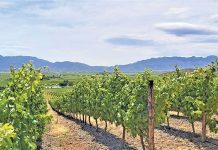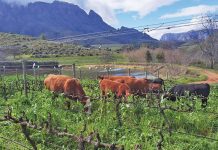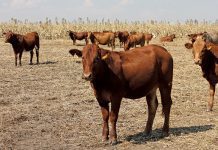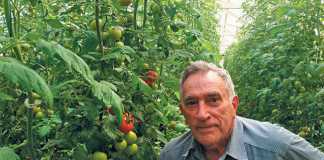
Photo: Wikimedia Commons
Climate change is a global issue that is affecting the way people live and interact with the environment.
Among its numerous effects, climate change has a significant impact on agricultural production systems, leading to patterns that vary, with positive as well as negative effects.
READ Empowering communities to cope with climate change
In order to ensure food security, economic stability, and environmental sustainability, agricultural practices need to adapt as the Earth’s climate continues to change, resulting in changes to temperature and precipitation patterns.
Farmers are finding it challenging to maintain consistent and predictable crop yields as a result of the escalating effects of climate change on traditional agricultural landscapes.
Global agricultural systems are being affected by factors such as rising temperatures, shifting rainfall patterns and a rise in the frequency of extreme weather events including heatwaves, floods and droughts.
In order to maintain production and profitability, these shifts are requiring farmers to reconsider existing methods, adopt new technologies and investigate other strategies.
Modifications in agricultural production patterns may also present chances for creativity and adaptability.
Utilising drought-tolerant crop varieties, precision irrigation and improved soil management techniques are just a few examples of the climate-smart agricultural practices that farmers can use to adapt.
By improving resource efficiency, lowering greenhouse gas emissions and conserving water, these modifications can support agricultural sustainability system.
Shifting patterns in the maize belt
In South Africa, maize is an important staple crop, and the success of the maize belt greatly influences agricultural output.
The Free State, Mpumalanga and North West are home to most of the maize belt. Significant variations in yield have resulted from the impact of climate change on maize production in this region during the past few decades.
Extended frost-free periods, brought on by changing patterns of precipitation and higher temperatures, have enabled farmers to plant maize earlier in the growing season and prolong the harvesting period.

As a result of a longer growth period and more favourable conditions for maize farming, certain areas have experienced increased yields.
The maize belt region is experiencing severe and more frequent droughts due to climate change. Crops are under water stress due to irregular rainfall patterns and extended dry periods, particularly during crucial growth stages.
Heat waves and droughts can have an adverse effect on maize plants, lowering yields and reducing the harvest overall quality.
Prolonged dry periods can have detrimental consequences and small-scale farmers are especially vulnerable since they generally lack access to resources including irrigation.
An additional negative impact of climate change on the maize belt is the rising incidence of extreme weather events.
READ Climate-proof, no-till crop production in the maize triangle
Severe storms, tremendous amounts of rainfall and sudden flooding can destroy crops, wash away topsoil and create erosion, all of which could decrease yields and increase production costs.
Such occurrences can also interfere with planting and harvesting schedules, which makes it difficult for farmers to effectively plan and manage their crops.
South African farmers are implementing a variety of adaptation strategies to deal with the changing environment and minimise the negative impact on maize production.
Investing in better irrigation systems to replace the water supply during dry periods and drought periods is one crucial strategy.
Additionally, researchers and agricultural experts are developing and promoting drought-resistant maize varieties that can better withstand water scarcity and heat stress.

Water resources for industrial use, agricultural irrigation and water supply are under pressure due to decreased rainfall, higher evaporation rates and changing hydrological patterns.
The shortage has an impact on water-dependent enterprises, rural livelihoods, and agricultural output.
Variations in temperature and precipitation patterns influence agricultural pest and disease dynamics.
A farm’s profitability can be impacted and sustainable pest management is difficult due to increased pest pressure and changed disease patterns that lower crop yields and increase the need for pesticides.
Furthermore, by limiting the supply of staple crops and increasing food prices, climate change could threaten food security if it leads to reduced agricultural production.
It is crucial to emphasise that the possible advantages are greatly outweighed by the overall negative implications.
On the other hand, some farmers may discover new ways to adjust to the changing environment, like moving to crop varieties that are more tolerant to heat or drought, shifting planting and harvesting periods and putting water-saving irrigation techniques into practice.
READ Cost-effective irrigation
New cultivars for prolonged or out-of-season cultivation assist with all-year-round sales and income flow. This is due to technological advancements.
Certain areas that were previously too cold for some crops may become more suitable for agriculture as a result of warmer temperatures.
This could enable growers to cultivate new varieties of crops that were historically inappropriate and diversify their crop selection.
Good infrastructure construction can allow for the storage of some water during heavy rains for later use.
South Africa could uncover new markets for its agricultural products, such as new-season maize cultivars to adjust to the new environment and take advantage of the opportunities brought about by shifting production patterns.
By ensuring an adequate and varied food supply, effective climate change adaptation and the development of new crops can improve food security.
Conclusion
Sustainable methods such as improving soil health, effective water use, promoting agroforestry and developing varieties of crops that are resilient to shifting weather patterns should be the focus of efforts to mitigate the effects of climate change and adapt to it.
This strategy could maximise long-term sustainability and productivity while reducing any potential negative effects of climate change.
Investing in the development of new technologies and water-efficient systems to mitigate the effects of drought also help minimise carbon emissions, which cause climate change and environmental destruction.
Also, promote curriculum reform and prioritise native and/or underutilised crops that are adapted to the local region since they can endure adverse environmental circumstances.
Email Natashia Qwabe at [email protected].











